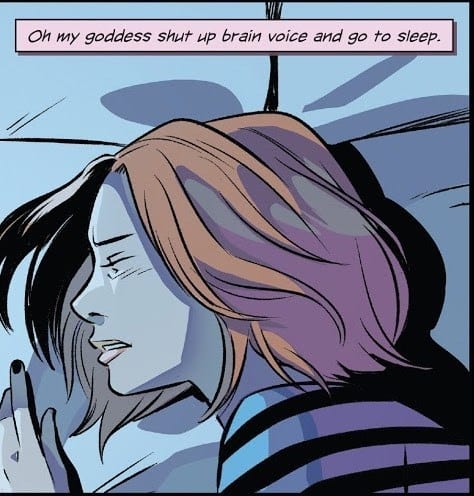Joss Whedon has created myriad iconic female characters throughout his career and yet, besides Buffy, I would defy anyone to find a Whedonverse character more beloved than Willow Rosenberg. She’s the ideal friend and sidekick; she’s loyal, loving, intelligent, and physically strong in her own right. It’s easy to fall under the spell of this red-haired lesbian (or bisexual?) Jewish witch.
It’s been seventeen years since Buffy the Vampire Slayer ended, and still, fans obsess over the nerdiest member of the Scooby Gang. While the enduring conversation about Willow revolves around her addiction storyline and gayness, an understated yet key aspect of the character is her Jewishness.
In the new spin-off series from BOOM! Studios, the creators can and should mine Willow’s Jewish identity. Mining her identity would not only bolster representation but broaden the character, taking her in a new direction. After all, Buffy was not created in a culturally-unaware vacuum. It was both sub-textually and textually feminist in correspondence with political movements of the period.
Furthermore, the series premiered during a new epoch of Jewish representation on television. Comedies like Seinfeld and The Nanny exposed folks from all over the world to Jews and Judaism. So, with or without the influence of producer and Jew Gail Berman, Willow Rosenberg’s Jewishness was most likely a deliberate response to the zeitgeist.
Singularly Jewish
Similar to television, the world of comics has always had a prominent Jewish presence behind the scenes. Unfortunately, this presence did not transfer to the comic book characters themselves until around ten years ago when writers such as Dan Slott (The Thing) and G. Willow Wilson (Ms. Marvel) created religious Jewish heroes.
Whedon himself said that Willow’s Jewishness and sexual orientation weren’t big issues. I’ve interpreted this statement as expressing a desire to normalize queerness and Jewishness on TV. But Willow is not presented as a religious Jew either in the show or the comic books. Can one normalize or even claim to represent a culture or belief without showing a character practicing and otherwise participating in it?
As Lisa Liebman noted in her article for Vanity Fair, a recent trend in Jewish television grew in response to a rise in anti-Semitic hate crimes across America. What’s interesting about the trend is that while there are shows representing secular Jews (Crazy Ex-Girlfriend), we have more shows than ever before representing religious Jews (Unorthodox, Shtisel). I don’t know whether the creators of these shows had any specific intent to normalize Orthodox Jews, but they found a way to make what’s “singularly Jewish [into something] broadly appealing.” Comic book writers have the same opportunity.
Jewitch
Willow does not necessarily need to be ret-conned as a Chassid or a committed socially-conscious Reform Jew to check off some representation box. Nonetheless, her Jewishness must go beyond a few quips about not “worshiping Santa.” Consider this: there is a movement called Semitic Neopaganism made up of “Jewitches.” According to Witchipedia, Jewitchery is either the “practice of witchcraft by a Jewish person or the integration of Wiccan spirituality with Jewish culture.” What if Willow took to some Jewitchery, or met a self-described Jewitch?
Witchcraft and Judaism go way back, anyway. Parts of the Bible unequivocally condemn witchcraft (mahashefah), yet Moses and Aaron do some things that would qualify as spells or magic. Thus, an exploration of Judaism and witchcraft could yield plenty of conflict and questions about identity.

As Willow #1 is the beginning, no Jewishness or much witchcraft has been brought up. Willow has left Sunnydale to study abroad in England, a move motivated by the heartbreaking events of the Buffy the Vampire Slayer: Hellmouth arc. She’s on a solo journey of self-discovery and freedom from literal hell. Will her journey lead her to a discovery of Jewitches? Only Mariko Tamaki and Boom! Studios’ creative team can tell.
Universal And Particular
By incorporating the religion and culture in Willow’s arc in some way, the writers can normalize a certain kind of Jewishness without compromising other aspects of the character. Religious folklore, ritual, and holidays may also serve the plot.
For example, in Issue #8 of The Thing‘s Idol of Millions arc, Ben Grimm gets the bar mitzvah he never had. Errors in representing the tradition notwithstanding, the issue uses Judaism to explore emotional backstory that perhaps previously wasn’t addressed. Most importantly, this coming-of-age ritual connects his adaptation to life as The Thing to a religious transition. What’s more, none of this comes at the expense of the character’s trademarks. Slott proves here that religion can “bolster storytelling and… identity”, to use the words of G. Willow Wilson.
I believe that many non-Jewish or simply non-religious creatives are too scared even to try developing anything seriously religious because they don’t think such a story is universal. They may also fear their project being labeled Jewish/Christian/Muslim, which would then somehow beholden them to cater to that demographic.
But these concerns prevent comic book creators from interpreting religion for plot and character. Even in the Year of Our Lord 2020, when politics and fiction have entered into a toxic Spike/Buffy relationship, Willow can be made Jewish (or a Jewitch) without the burden of social commentary.

